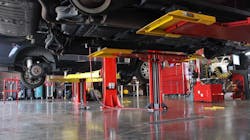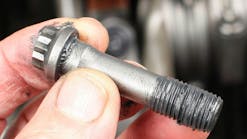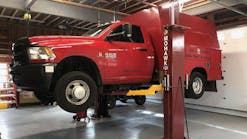How To Maximize Service Bay Safety And Productivity
As a shop owner or manager, you’re responsible for maximizing service bay productivity and safety. The Automotive Lift Institute (ALI) recommends taking these five steps to help your team operate vehicle lifts safely and productively.
1. Choose the right lift
Your team needs the proper tools and equipment to get the job done right. There are several factors to consider when choosing a new lift:
- The lift should have sufficient capacity to raise the vehicles you service.
- The lift should be equipped to reach the vehicle manufacturer’s recommended lifting points.
- Pay attention to clearances around and above the lift.
Remember that there is no one-size-fits-all lift, so most general service shops will need more than one lift type.
Lift Certification
When installing any vehicle lift in a location where building code or health and safety officials have jurisdiction, always choose a lift that bears ALI’s gold certification label. Lifts that wear the gold ALI certification label have been third-party tested and proven to meet all the requirements of North America’s applicable electrical and mechanical safety standards.
The ANSI (American National Standards Institute)/ALI ALCTV (current edition), Standard for Automotive Lifts Safety Requirements for Construction, Testing and Validation, is the primary standard that applies to all vehicle lifts. Lift testing to this standard includes verification of the structural integrity of all the lift’s systems and components, proper function of its controls and load-holding devices, proper lowering speeds and overload protection. For a lift to be certified, the manufacturer’s production facility is also audited to confirm it meets quality control requirements.
Lifts of any size or capacity can be tested and certified regardless of where they are manufactured. Membership in ALI is not a requirement.
For a list of certified lifts, visit the ALI Directory of Certified Lifts at www.autolift.org/ali-directory-of-certified-lifts/. If a new lift does not carry the ALI gold label, it is not certified and should not be purchased or installed.
When installing a used lift, it is important to check building codes, as lifts certified to previous standards may not meet current safety requirements. Not all lifts for sale in today’s market are certified, regardless of country of origin. It is up to you (as the purchaser) to make sure the lifts you buy are certified.
Building Codes
Check your local building code requirements. The International Building Code, which is in use or adopted by all 50 U.S. states, requires that all installed vehicle lifts conform with ANSI/ALI ALCTV. So, if you’re having a lift installed in an area covered by the International Building Code, you must choose an ALI-certified lift.
Each Canadian province also has its own specific building code requirements which must be satisfied.
Remember to check with local code enforcement officials if you are unsure of the requirements. Should you find the code department does not have experience in the area of permitting newly purchased or relocated vehicle lifts, a visit to the ALI website or a call by the code officer could be helpful in avoiding unnecessary expense or startup delays.
Accessories
Many people don’t realize that lift options and accessories are approved for use with specific lift models. Approved options and accessories are also subject to third-party testing and certification.
Use of non-certified options or accessories on a certified lift will void the lift’s certification for as long as the original configuration remains altered. Be sure to order the certified accessories your technicians need for each lift.
A list of accessories certified for use with each lift is listed in the ALI Directory of Certified Lifts.
2. Use a qualified installer
Because proper installation is crucial to the safe operation of your vehicle lifts, have your lifts installed by someone who has been properly trained to do so. The ANSI/ALI ALIS (current edition), Standard for Automotive Lifts Safety Requirements for Installation and Service, outlines installer qualifications, including formal training by the lift manufacturer and experience in lift operation and installation.
The installer should also be familiar with the appropriate federal regulations governing workplace safety, specifically the requirements for walking-working surfaces, hazardous materials, personal protective equipment, general environmental controls, compressed gas and compressed air equipment, and machinery/machine guarding.
Find a qualified lift installer or confirm an installer’s qualifications by contacting the lift manufacturer.
The final authority in all matters regarding lift installation is the lift manufacturer’s instructions.
3. Train lift operators
Only people who have been properly trained should operate a vehicle lift. Make sure every technician in your shop has been trained on the safe use and operation of each lift they will operate.
Training should be based on the lift manufacturer-provided instructions and warning labels, as well as the ALI publications Vehicle Lifting Points for Frame-Engaging Lifts, Lifting It Right, Safety Tips and the ANSI/ALI ALOIM (current edition), Standard for Automotive Lifts Safety Requirements for Operation, Inspection and Maintenance.
Document this training. You may be asked to show this documentation at a future health and safety or insurance inspection.
A convenient resource for general vehicle lift safety training is ALI’s Lifting It Right online training course, which has been completely updated for 2017. This interactive training course covers lift types, proper lift operation and maintenance. At the conclusion of the course, the technician takes an online test.
A certificate of completion is generated and stored online for those who pass the test. This gives you peace of mind that if a safety inspector visits your service department, you can quickly and easily produce documentation that your technicians have been trained.
Know, too, that part of your lift operators’ responsibilities are to examine each lift they operate on a daily basis. The items to be examined are described in the ANSI/ALI ALOIM (current edition) standard and in the lift manufacturer’s lift-specific instructions.
Copies of all ALI training materials are available from ALI member companies, ALI Certified Lift Inspectors and online at www.autolift.org/ali-store/.
4. Schedule annual lift inspections
Every vehicle lift must be inspected at least annually by a qualified lift inspector, and more frequently if required by the lift manufacturer or local regulations. This requirement can be found in ANSI/ALI ALOIM (current edition).
The easiest way to make sure you hire a qualified lift inspector is to choose an ALI Certified Lift Inspector. These individuals have been tested and found qualified to inspect any vehicle lift.
To achieve certification, lift inspectors must pass two written exams, complete extensive documented practical experience and agree to abide by the program’s code of ethics. The inspector’s employer also must meet quality requirements and sign an additional code of ethics.
A searchable online directory of ALI Certified Lift Inspectors is available at www.autolift.org/find-a-certified-auto-lift-inspector/.
ALI Certified Lift Inspectors examining a lift to the requirements of ALI’s program follow standardized inspection procedures for every lift, regardless of age, origin or manufacturer. They assess the lift, bay and shop, and provide written reports with any repair recommendations after the inspection.
The Certified Lift Inspector applies a serialized, dated and signed (with the inspector’s unique ID number) label to each lift that passes inspection, making it clear at a glance when the lift was last successfully inspected.
5. Establish a planned maintenance schedule
Follow the recommendations of the lift manufacturer to establish and follow a documented planned maintenance procedure for every lift to ensure reliability and allow its continued safe operation. This procedure should outline what is checked as part of the planned maintenance program and how frequently.
Keep a thorough written record of each check made, the parts replaced, the results of any measurements taken and the recommendations made.
Never modify or reconstruct a lift without the manufacturer’s express written permission. Always replace worn, damaged or broken parts with parts approved by the original equipment manufacturer.
Remember, a safe shop is a productive shop. For the safety of your technicians, your customers and your business, follow these five steps to choose the right lifts, make sure they’re properly installed and keep them running as they should.
R.W. “Bob” O’Gorman is president of the Automotive Lift Institute (ALI), a trade association of North American-based lift manufacturers (www.autolift.org). Its mission is to promote the safe design, construction, installation, service, inspection and use of automotive lifts.


